
Bivalvia, in previous centuries referred to as the Lamellibranchiata and Pelecypoda, is a class of marine and freshwater molluscs that have laterally compressed bodies enclosed by a shell consisting of two hinged parts. Bivalves as a group have no head and they lack some usual molluscan organs like the radula and the odontophore. They include the clams, oysters, cockles, mussels, scallops, and numerous other families that live in saltwater, as well as a number of families that live in freshwater. The majority are filter feeders. The gills have evolved into ctenidia, specialised organs for feeding and breathing. Most bivalves bury themselves in sediment where they are relatively safe from predation. Others lie on the sea floor or attach themselves to rocks or other hard surfaces. Some bivalves, such as the scallops and file shells, can swim. The shipworms bore into wood, clay, or stone and live inside these substances.

The Pacific geoduck is a species of very large saltwater clam in the family Hiatellidae. The common name is derived from the Lushootseed (Nisqually) word gʷídəq.
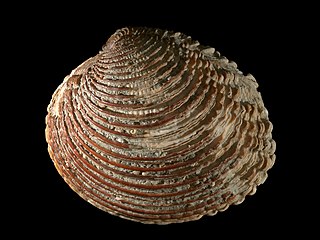
The Veneridae or venerids, common name: venus clams, are a very large family of minute to large, saltwater clams, marine bivalve molluscs. Over 500 living species of venerid bivalves are known, most of which are edible, and many of which are exploited as food sources.

Mercenaria is a genus of edible saltwater clams, marine bivalve molluscs in the family Veneridae, the Venus clams.

Venus is a genus of small to large saltwater clams in the family Veneridae, which is sometimes known as the Venus clams and their relatives. These are marine bivalve molluscs.
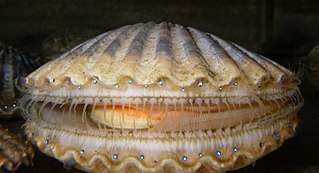
The Pteriomorphia comprise a subclass of saltwater clams, marine bivalve molluscs. It contains several major orders, including the Arcida, Ostreida, Pectinida, Limida, Mytilida, and Pteriida. It also contains some extinct and probably basal families, such as the Evyanidae, Colpomyidae, Bakevelliidae, Cassianellidae, and Lithiotidae.

Heterodonta is a taxonomic subclass of saltwater clams, marine bivalve molluscs. This subclass includes the edible clams, the cockles and the Venus clams.

Mactridae, common name the trough shells or duck clams, is a family of saltwater clams, marine bivalve mollusks in the order Venerida.
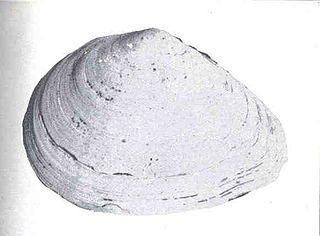
Macoma nasuta, commonly known as the bent-nosed clam, is a species of bivalve found along the Pacific Ocean coast of North America. It is about 6 cm (2.4 in) long. It is often found buried in sands of 10–20 cm (3.9–7.9 in) in depth. This rounded clam has no radial ribs. Archaeological data supports the use of this species by Native Americans such as the Chumash peoples of central California.
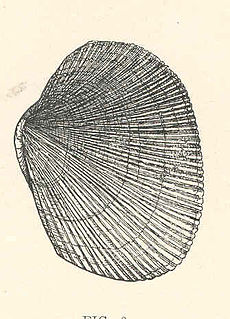
Leukoma staminea, commonly known as the Pacific littleneck clam, the littleneck clam, the rock cockle, the hardshell clam, the Tomales Bay cockle, the rock clam or the ribbed carpet shell, is a species of bivalve mollusc in the family Veneridae. This species of mollusc was exploited by early humans in North America; for example, the Chumash peoples of Central California harvested these clams in Morro Bay approximately 1,000 years ago, and the distinctive shells form middens near their settlements.
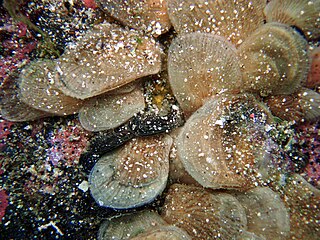
Isognomon is a genus of marine bivalve mollusks which is related to the pearl oysters.

Pododesmus macrochisma, common name the green falsejingle or the Alaska jingle, is a species of saltwater clam, a marine bivalve mollusc in the family Anomiidae, the jingle shells.

Periglypta is a genus of bivalves in the family Veneridae.
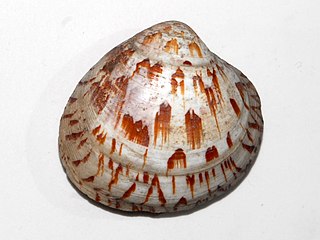
Lioconcha is a genus of molluscs in the family Veneridae.

Pectinida is a taxonomic order of large and medium-sized saltwater clams, marine bivalve molluscs, commonly known as scallops and their allies. It is believed that they began evolutionarily in the late Middle Ordovician epoch; many species, of course, are still extant.

Hinge teeth are part of the anatomical structure of the inner surface of a bivalve shell, i.e. the shell of a bivalve mollusk. Bivalves by definition have two valves, which are joined together by a strong and flexible ligament situated on the hinge line at the dorsal edge of the shell. In life, the shell needs to be able to open slightly to allow the foot and siphons to protrude, and then close again, without the valves moving out of alignment with one another. To make this possible, in most cases the two valves are articulated using an arrangement of structures known as hinge teeth. Like the ligament, the hinge teeth are also situated along the hinge line of the shell.

Lioconcha castrensis, common name the zigzag venus, is a species of saltwater clam, a marine bivalve mollusc in the family Veneridae, the venus clams.

Venus nux is a species of saltwater clam. They are marine bivalve molluscs in the family Veneridae, sometimes known as the venus clams.

Megapitaria squalida, the chocolate clam, is a species of bivalve mollusc in the family Veneridae. It was first described to science by George Brettingham Sowerby, a British conchologist, in 1835. The type specimen was collected by Hugh Cuming.

















